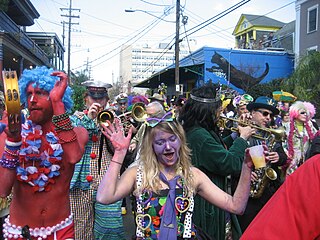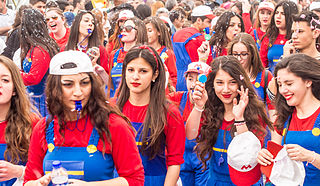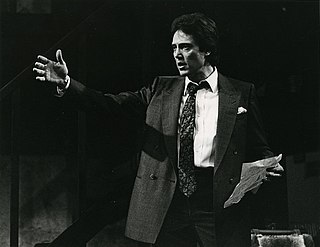
Mardi Gras, or Fat Tuesday, refers to events of the Carnival celebration, beginning on or after the Christian feasts of the Epiphany and culminating on the day before Ash Wednesday. Mardi Gras is French for "Fat Tuesday", reflecting the practice of the last night of eating rich, fatty foods before the ritual fasting of the Lenten season.

The Carnival of Brazil is an annual Brazilian festival held between the Friday afternoon before Ash Wednesday and Ash Wednesday at noon, which marks the beginning of Lent, the forty-day period before Easter. During Lent, Roman Catholics and some other Christians traditionally abstained from the consumption of meat and poultry, hence the term "carnival", from carnelevare, "to remove meat."

Barranquilla's Carnival is one of Colombia's most important folkloric celebrations, and one of the biggest carnival in the world. The carnival has traditions that date back to the 19th century. Four days before Holy Month, Barranquilla decks itself out to receive national and foreign tourists and joins together with the city's inhabitants to enjoy four days of intense festivities. During the carnival, Barranquilla's normal activities are paralyzed because the city gets busy with street dances, musical and masquerade parades. Barranquilla's Carnival includes dances such as the Spanish paloteo, African congo, and indigenous mico y micas. Many styles of Colombian music are also performed, most prominently cumbia, and instruments include drums and wind ensembles. The Carnival of Barranquilla was proclaimed a Cultural Masterpiece of the Nation by Colombia's National Congress in 2002. Also the UNESCO, in Paris on November 7, 2003, declared it one of the Masterpieces of the Oral and Intangible Heritage of Humanity, and it was during Olga Lucia Rodriquez Carnival Queen starts on the Saturday before the Ash Wednesday with the Battle of the Flowers, which is considered one of the main activities. Then, The Great Parade on Sunday and Monday is marked by an Orchestra Festival with Caribbean and Latin bands. Tuesday signals the end of the carnival, announced by the burial of Joselito Carnaval, who is mourned by everyone.
The carnival in Colombia was introduced by the Spaniards. The Colombian carnival has incorporated elements from European culture, and has managed to syncretise, or re-interpret, traditions that belonged to the African and Amerindian cultures of Colombia. There is documentary evidence that the carnival existed in Colombia in the 17th century and had already caused concern to the colonial authorities, who censored the celebrations, especially in the main centers of power such as Cartagena, Bogotá and Popayán. The carnival, therefore, continued its evolution and re-interpretation in the small and at that time unimportant towns where celebrations did not offend the ruling elites. The result was the uninterrupted celebration of carnival festivals in Barranquilla, and other villages along the lower Magdalena River in northern Colombia, and in Pasto, Nariño in the south of the country. In modern times, there have been attempts to introduce the carnival in the capital, Bogotá, in the early 20th century, but it has always failed to gain the approval of authorities. The Bogotá Carnival has had to wait until the 21st century to be resurrected, this time, by the authorities of the city. Colombia is recognized by its large variety of festivals, carnivals and fairs. Most towns have their own, ranging from those celebrating coffee to the ones held in honor of the town's Saint feast. The common characteristics of the festivals are the nomination of a beauty Queen and the setting up of public dance floor.

The Carnival in Rio de Janeiro is a festival held every year before Lent and considered the biggest carnival in the world with two million people per day on the streets. The first Carnival festival in Rio occurred in 1723.

Kurentovanje is one of Slovenia's most popular and ethnologically significant carnival events. This 10-day rite of spring and fertility is celebrated on Shrove Sunday in Ptuj, the oldest documented city in the region, and draws around 10,000 participants each year.

Riosucio is a town and municipality in the department of Caldas in Colombia. It is best known for its biennial carnival, officially called the Carnival of Riosucio but commonly known by its former name of the "Carnival of the Devil", and is one of the biggest and most popular carnivals in Colombia.

The Paris Carnival is a carnival in the city of Paris in France. It occurs after the Feast of Fools and has been held since the sixteenth century or earlier, with a long 20th century interregnum.

The Carnival of Santa Cruz de Tenerife is held each February in Santa Cruz de Tenerife, the capital of the largest of the Canary Islands, and attracts people from all over the world.

Holy Week in Spain is the annual tribute of the Passion of Jesus Christ celebrated by Catholic religious brotherhoods and fraternities that perform penance processions on the streets of almost every Spanish city and town during the last week of Lent, the week immediately before Easter.

The Carnival of Madeira is an annual festival held forty days before Easter, that ends on Shrove Tuesday the day before Ash Wednesday. On certain days of Lent, Roman Catholics traditionally abstained from the consumption of meat and poultry, hence the term "carnival," from carnelevare, "to remove meat."
Haitian Carnival is a celebration held over several weeks each year leading up to Mardi Gras. Haitian Defile Kanaval is the Haitian Creole name of the main annual Mardi Gras carnival held in Port-au-Prince, Haiti.
Carnival in Mexico is celebrated by about 225 communities in various ways, with the largest and best known modern celebrations occurring in Mazatlan and the city of Veracruz.

Carnival of Huejotzingo is one of Mexico’s carnivals, which takes place in the Huejotzingo municipality in the state of Puebla.

The Carnival of Aalst or Aalst Carnival is a yearly three-day event in the Belgian city of Aalst. It is recognised by UNESCO as a Masterpiece of the Oral and Intangible Heritage of Humanity. The carnival is celebrated in the days preceding Ash Wednesday. It is mainly a street happening; the celebrants dance on the city squares and visit café after café.

Jember Fashion Carnaval or JFC is an annual carnival held in the East Java city of Jember. Officially it is written as Jember Fashion Carnaval; the word carnival here is officially spelled as carnaval, probably a confusion with Indonesian spelling karnaval, or an influence of the Dutch spelling carnaval. Jember Fashion Carnival has no relation with the Christian pre-Lenten festival, but more of a festivities in general, roughly following the Brazilian style, with procession of dancers in extravagant costumes, with emphasis on the traditional Indonesian motif.
Carnival is the most important and well-known festivity celebrated in Tarazona de la Mancha, in the Spanish province of Albacete.

Carnival in French Guiana is a major event. Its style is described as Afro-Caribbean. It was established in 1884 following the abolition of slavery. A moveable holiday, it takes place between Epiphany and Ash Wednesday, ending on Mardi Gras. The participants – French, Brazilian, Chinese and Creole people – dress in vibrant costumes. Main events include a parade and a burlesque-style marriage.

The Limassol Carnival Festival is an annual European carnival event held at Limassol, Cyprus. It is considered one of the most notable carnival events worldwide. The event is held 12 days before the Christian season of Lent on the Sunday before Ash Monday, 50 days before Orthodox Easter. The festival is a 10-day colourful event of people feasting, singing songs, satire, games, carnival processions and balls.





















